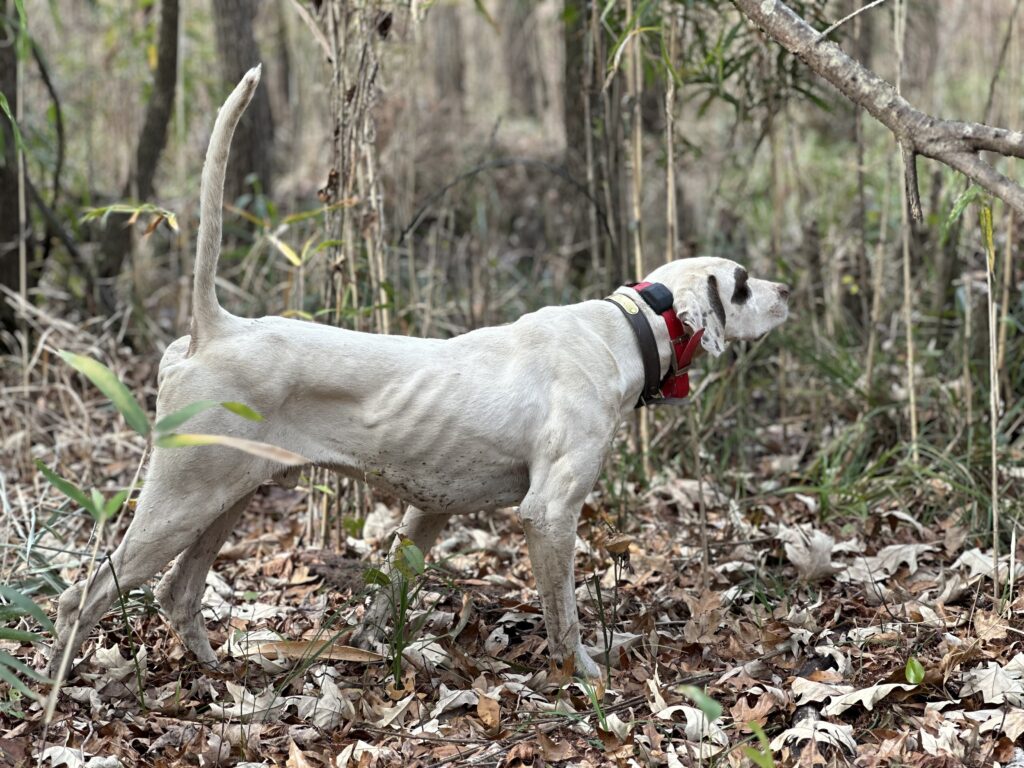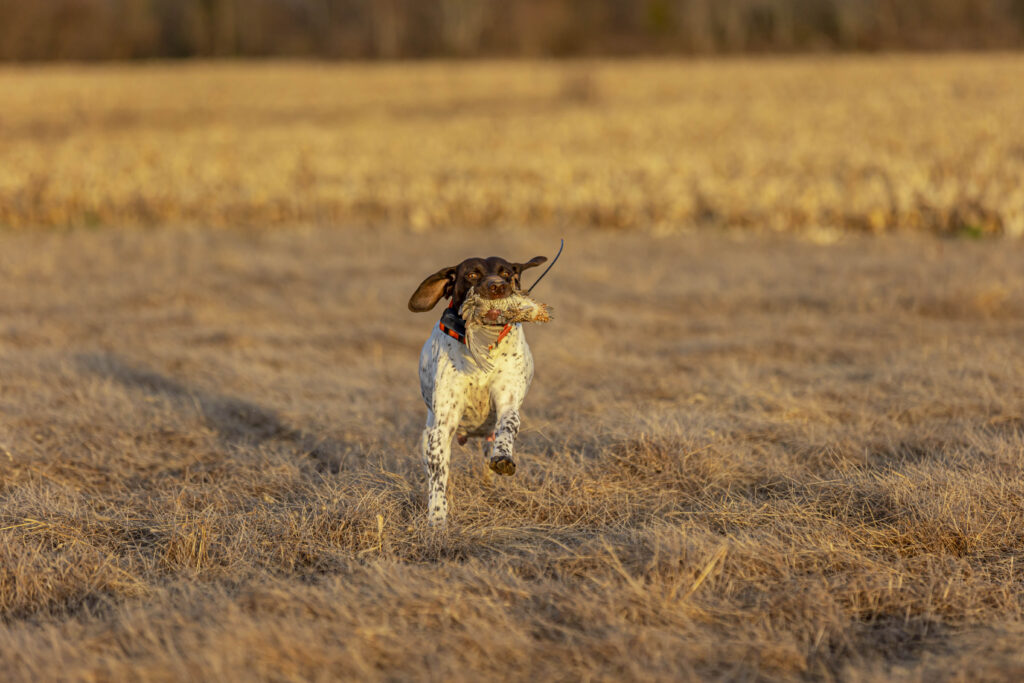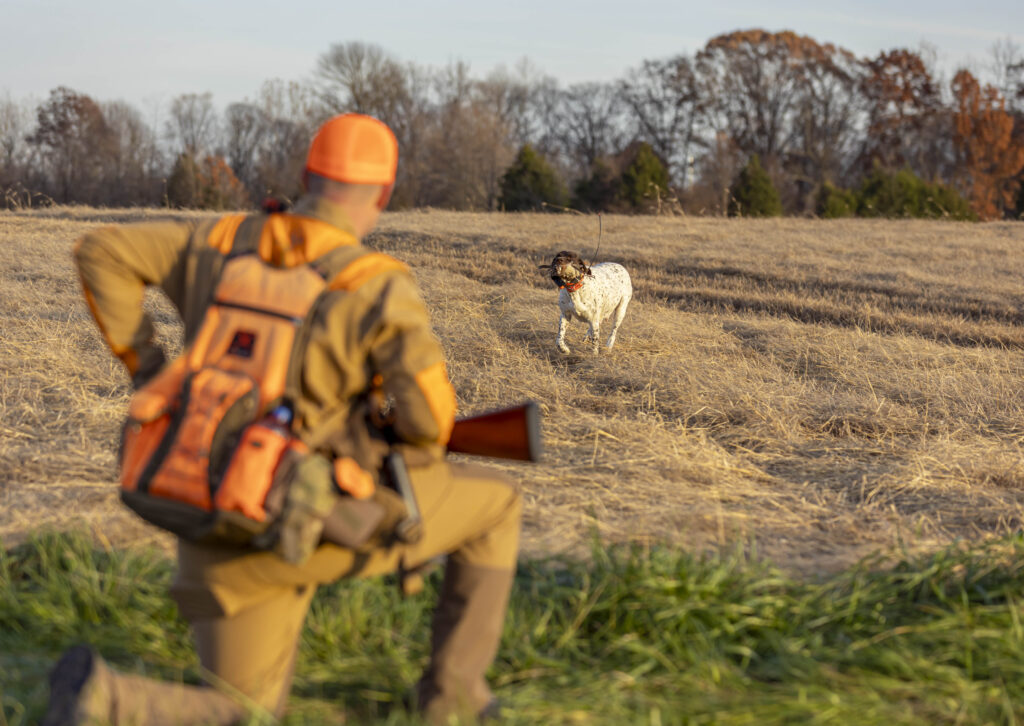Can You Hunt A Pregnant Dog?

Understanding Canine Estrous Can Help Inform Your Decisions Around Hunting Season and Your Dog’s Pregnancy
By Shawn K. Wayment, DVM
The classic upland image is a staunch pointer or a setter with a poker straight, high tail with her jowls held intensely as the professional handler strokes her to straighten her tail and gently coos, “Woooooop”—cautioning her not to creep.
Silence from the gallery behind her is deafening, even the walkers and trotters sense the electricity in the air. The handler removes his starter pistol from its leather holster and moves in front of the dog. Eruption from beneath the broom-straw grass breaks the silence as a covey of bobwhite quail escapes to safety through the longleaf and loblolly pines.
The smoke from the starter pistol permeates the senses while the gallery whispers how well the bitch handled her birds. One member divulged that she could not believe that this bitch was six weeks pregnant and handled the hour-long competition as well as any of the other non-pregnant bird dogs.

There is a great deal of information on pregnant athletes and some women have even competed in the Olympics at intense levels while pregnant. Pregnant women have competed in fencing, synchronized swimming, beach volleyball, archery, and track & field. Most of the research on pregnant athletes is on humans, horses, and laboratory rodents. There is not much information on field trialing, sled racing, coursing, or even hunting athletic bird dogs during their gestation period, which poses the questions, can you hunt a pregnant dog, or should you at all?
What I have found in the literature and heard from professional trainers on running pregnant hunting dogs is mostly old wives’ tales and mere superstitions. Many professional trialers and dog handlers that raise and compete bird dogs believe that running their pregnant bitches on birds and having them point birds during pregnancy will pass on the pointing trait to their offspring. I have even heard of pregnant bitches running in big regional competitions at six to seven weeks of gestation and they competed just fine without any untoward consequences to their puppies.
Understanding Canine Pregnancy
Having a basic knowledge of the canine estrous (reproductive cycle) before trialing or hunting your pregnant dog is valuable and empowering and will help to inform your decisions to properly plan around the hunting season and your dog’s pregnancy. Understanding the canine estrus cycle can also aid in timing the day of ovulation which helps predict their whelping date and provides you a framework for keeping them both properly conditioned and in a place to protect her and her puppies.

Domestic dogs are monestrus which means they complete one full cycle to the completion of ovulation per estrus (heat) cycle. Their cycle is not dependent on what time of year or season it is, and they can cycle one to four times per year depending on the breed or individual. The canine estrus cycle is divided into the four stages of proestrus, estrus, diestrus, and finally anestrus.
Proestrus is the beginning of the heat cycle (duration of about seven to nine days on average) where the bitch attracts the male but she is not receptive to mating just yet. During proestrus, her vulva will start to swell and a serosanguineous (reddish-blood and serum) discharge will develop. Estrogen is the main hormone that is regulating the behavioral and clinical signs of the bitch. Progesterone levels are low (<1 ng/ml) and the cells seen under the microscope will consist of red blood cells, white blood cells, and normal vaginal epithelial cells
Estrus is the next stage of the heat cycle and can range from one to three weeks in duration on average. This is the time when the bitch is receptive to the male. Hormonally, estrogen levels will begin to drop and progesterone levels will begin to rise. The vulva is still swollen and has a lighter pink discharge instead of the red bloody discharge seen in proestrus. Estrus is complete when the eggs from the ovaries are ovulated and become mature for fertilization to occur. Vaginal epithelial cells seen under the microscope are mostly cornified and there is not a lot of “background” cells such as red blood cells and white blood cells.
Diestrus is the next stage to follow in the estrus cycle and can range up to four months in length. During this stage, the bitch is no longer receptive to the male, and her vulva returns to normal with no visible discharge. Progesterone levels are at their highest concentration during this phase. Mammary development occurs at the end of this period prior to parturition or whelping of the puppies.
Finally, anestrus is the last phase of the heat cycle, and this is the longest period lasting up to four months or more. During anestrus, the bitch is not receptive to mating and the estrogen and progesterone levels are at their lowest. This is considered a dormant or inactive stage of the canine estrus cycle.
Breeding occurs during the estrus phase of the canine reproductive process and conception takes place in the oviducts or fallopian tubes. Most bitches are covered every other day until they are no longer receptive to the male. Once conception takes place, the fertilized eggs do not implant in the uterus for 14 to 18 days—these fertilized eggs float around in the uterus before attaching to the uterine wall to become an embryo. These free-floating embryos stimulate the uterus so that the bitch’s body recognizes that she is pregnant. The canine gestation period is 62 to 64 days post-ovulation. Timing of ovulation is critical to help accurately figure out the bitch’s whelping date.

Staying Safe in the Field
We know our hunting dogs are ultra-athletes and need to keep moving, so is it safe, and how far into her pregnancy can she be trialed or hunted? All pregnant dogs should receive some form of physical exercise to help keep their body in healthy working condition. Exercise should not be forced, and the bitch will start to show her limitations when the puppies are taking up enough space in her abdomen that the diaphragm can not move normally during exercise.
Well-conditioned, athletic dogs can be safely hunted or trialed through their first and second trimesters without causing any harm to their puppies. During the first two trimesters, there is not very much uterine development and most of the rapid fetal growth occurs during the last 12 days of gestation or during the third trimester.
Planning Around Canine Pregnancy
Make sure you have a correct estimate of her due date. Be judicial about running her during extreme temperature conditions, too. Pregnant bitches can overheat easily and can become dehydrated very quickly. Force water breaks often during exercise.
There are of course, additional risks to running your pregnant dog during the hunting season or campaigning her in competitions during her pregnancy. Most adult competition dogs have already been exposed to the canine herpes virus. There is minor risk of an adult dog contracting the virus at a competition. Canine herpes virus in adult dogs can cause upper respiratory disease, which is generally mild, but it can be fatal to puppies. Canine herpes virus can cause late term abortion in pregnant bitches. There are no vaccines to prevent the virus, and treatment is limited to supportive care. A good rule of thumb is to stop trialing or competing a pregnant bitch three weeks before she whelps and then keep her and the newborn puppies isolated for the first three weeks of their lives. Thankfully, hunting dogs are less likely to be exposed to the canine herpes virus than dogs at competitions.

Dogs eat everything which poses a risk to a pregnant one picking up a parasite. Roundworms and hookworms can travel from mom to the puppies through the placenta. A good parasite prevention program during pregnancy will keep their puppies from getting worms, and you can also mitigate this threat by keeping a close eye on her whereabouts while she is out in the field during pregnancy.
Proper nutrition during pregnancy is paramount. The amount of food fed or an increase in calories does not really need to increase until the third trimester. Rapid changes in diet can lead to digestive problems. Be sure to make all food changes slowly to prevent digestive issues in your pregnant bitch.
One final note, always use good judgement before competing or hunting your pregnant dog. If it is too hot outside or your dog is unfit, do not run them. It is always an excellent idea to have your veterinarian or reproduction specialist examine your dog and recommend if they are in shape to compete or hunt during pregnancy.

